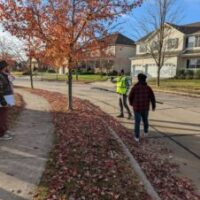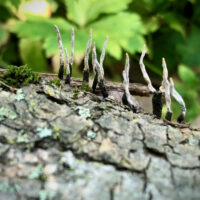 Purdue University - Extension - Forestry and Natural Resources
Purdue University - Extension - Forestry and Natural Resources
Got Nature? Blog
In this edition of ID That Tree, we’re going to introduce you to a native Indiana species, and that’s sourwood. It’s much more common in the Appalachian mountain range, but can be found on Indiana’s southern boundary across the Ohio River. Sourwood gets its name from its sour/bitter flavor when you taste it. It has alternate leave arrangement, simple leaves, and very finely serrated margins. It can also put on a great fall color.
If you have any questions regarding wildlife, trees, forest management, wood products, natural resource planning or other natural resource topics, feel free to contact us by using our Ask an Expert web page.
Resources:
ID That Tree, Playlist, Purdue Extension – Forestry and Natural Resources (FNR) YouTube Channel (Invasive White Mulberry, Siberian Elm, Tree of Heaven)
Invasive Species Playlist, Playlist, Purdue Extension – FNR YouTube Channel (Asian Bush Honeysuckle, Burning Bush, Callery Pear, Multiflora rose)
A Woodland Management Moment, Playlist, Purdue Extension – FNR YouTube Channel (Against Invasives, Garlic Mustard, Autumn Olive)
Woodland Stewardship for Landowners, Playlist, Purdue Extension – FNR YouTube Channel (Common Buckthorn, Japanese Barberry)
How long do seeds of the invasive tree, Ailanthus altissima remain viable? (Invasive Tree of Heaven), USDA Forest Service
Indiana Department of Natural Resources: Invasive Species
Indiana Invasive Species Council
Cooperative Invasive Species Management Area (CISMA)
Report Invasive, Purdue Extension
Aquatic Invasive Species, Illinois-Indiana Sea Grant (IISG)
Episode 11 – Exploring the challenges of Invasive Species, Habitat University-Natural Resource University
What are invasive species and why should I care?, Got Nature? Blog, Purdue Extension – FNR
Shrubs and Woody Vines of Indiana and the Midwest, The Education Store, Purdue Extension Resource Center
Native Trees of the Midwest, The Education Store
Investing in Indiana Woodlands, The Education Store
Professional Forester, Indiana Forestry Woodland Owners Association
District Forester 10+acres of woodlands, Indiana Department of Natural Resources
Forest Improvement Handbook, The Education Store
Lenny Farlee, Extension Forester
Hardwood Tree Improvement and Regeneration Center
Purdue Department of Forestry & Natural Resources
In this edition of ID That Tree, we’re going to introduce you to two species found in Indiana. One of them is a native called blackhaw, and the other an invasive called burning bush. Blackhaw has opposite simple leaves, very finely toothed margins, and elongated buds that have a grey haze to them. It also has a striking fall color. Burning bush on the other hand is an invasive spread by seeding itself through birds and other wildlife. It also has opposite leaf arrangement but much smaller leaves that are a bit more elongated.
If you have any questions regarding wildlife, trees, forest management, wood products, natural resource planning or other natural resource topics, feel free to contact us by using our Ask an Expert web page.
Resources:
ID That Tree, Playlist, Purdue Extension – Forestry and Natural Resources (FNR) YouTube Channel (Invasive White Mulberry, Siberian Elm, Tree of Heaven)
Invasive Species Playlist, Playlist, Purdue Extension – FNR YouTube Channel (Asian Bush Honeysuckle, Burning Bush, Callery Pear, Multiflora rose)
A Woodland Management Moment, Playlist, Purdue Extension – FNR YouTube Channel (Against Invasives, Garlic Mustard, Autumn Olive)
Woodland Stewardship for Landowners, Playlist, Purdue Extension – FNR YouTube Channel (Common Buckthorn, Japanese Barberry)
Invasive Plant Series: Winged Burning Bush, Got Nature? Blog, Purdue Extension – FNR
Invasive Plant Series: Winged Burning Bush, The Education Store
How long do seeds of the invasive tree, Ailanthus altissima remain viable? (Invasive Tree of Heaven), USDA Forest Service
Indiana Department of Natural Resources: Invasive Species
Indiana Invasive Species Council
Cooperative Invasive Species Management Area (CISMA)
Report Invasive, Purdue Extension
Aquatic Invasive Species, Illinois-Indiana Sea Grant (IISG)
Episode 11 – Exploring the challenges of Invasive Species, Habitat University-Natural Resource University
What are invasive species and why should I care?, Got Nature? Blog, Purdue Extension – FNR
Shrubs and Woody Vines of Indiana and the Midwest, The Education Store, Purdue Extension Resource Center
Native Trees of the Midwest, The Education Store
Investing in Indiana Woodlands, The Education Store
Professional Forester, Indiana Forestry Woodland Owners Association
District Forester 10+acres of woodlands, Indiana Department of Natural Resources
Forest Improvement Handbook, The Education Store
Lenny Farlee, Extension Forester
Hardwood Tree Improvement and Regeneration Center
Purdue Department of Forestry & Natural Resources
In this edition of ID That Tree, we’re going to introduce you to a native Indiana species, and that’s grey birch. It can be found in the northern part of Indiana near Lake Michigan. It can be defined by its long and pointed triangular shape, and it toothed margins on the edges of the leaf. It has very limber twigs and the leaves are arranged alternately. Also the fruiting flower structure can be identified as a catkin.
If you have any questions regarding wildlife, trees, forest management, wood products, natural resource planning or other natural resource topics, feel free to contact us by using our Ask an Expert web page.
Resources:
ID That Tree, Playlist, Purdue Extension – Forestry and Natural Resources (FNR) YouTube Channel (Invasive White Mulberry, Siberian Elm, Tree of Heaven)
Invasive Species Playlist, Playlist, Purdue Extension – FNR YouTube Channel (Asian Bush Honeysuckle, Burning Bush, Callery Pear, Multiflora rose)
A Woodland Management Moment, Playlist, Purdue Extension – FNR YouTube Channel (Against Invasives, Garlic Mustard, Autumn Olive)
Woodland Stewardship for Landowners, Playlist, Purdue Extension – FNR YouTube Channel (Common Buckthorn, Japanese Barberry)
How long do seeds of the invasive tree, Ailanthus altissima remain viable? (Invasive Tree of Heaven), USDA Forest Service
Indiana Department of Natural Resources: Invasive Species
Indiana Invasive Species Council
Cooperative Invasive Species Management Area (CISMA)
Report Invasive, Purdue Extension
Aquatic Invasive Species, Illinois-Indiana Sea Grant (IISG)
Episode 11 – Exploring the challenges of Invasive Species, Habitat University-Natural Resource University
What are invasive species and why should I care?, Got Nature? Blog, Purdue Extension – FNR
Shrubs and Woody Vines of Indiana and the Midwest, The Education Store, Purdue Extension Resource Center
Native Trees of the Midwest, The Education Store
Investing in Indiana Woodlands, The Education Store
Forest Improvement Handbook, The Education Store
Lenny Farlee, Extension Forester
Hardwood Tree Improvement and Regeneration Center
Purdue Department of Forestry & Natural Resources
In this edition of ID That Tree, we’re going to introduce you to a native Indiana oak species, and that’s blackjack oak. It can be found in high, dry, rocky ridges where soil moister is limited. It can be defined by it’s bear paw shaped leaves that tend to be very shiny and waxy on top, and have a leathery texture. While on the underside it tends to have a rusty color.
If you have any questions regarding wildlife, trees, forest management, wood products, natural resource planning or other natural resource topics, feel free to contact us by using our Ask an Expert web page.
Resources:
ID That Tree, Playlist, Purdue Extension – Forestry and Natural Resources (FNR) YouTube Channel (Invasive White Mulberry, Siberian Elm, Tree of Heaven)
Invasive Species Playlist, Playlist, Purdue Extension – FNR YouTube Channel (Asian Bush Honeysuckle, Burning Bush, Callery Pear, Multiflora rose)
A Woodland Management Moment, Playlist, Purdue Extension – FNR YouTube Channel (Against Invasives, Garlic Mustard, Autumn Olive)
Woodland Stewardship for Landowners, Playlist, Purdue Extension – FNR YouTube Channel (Common Buckthorn, Japanese Barberry)
How long do seeds of the invasive tree, Ailanthus altissima remain viable? (Invasive Tree of Heaven), USDA Forest Service
Indiana Department of Natural Resources: Invasive Species
Indiana Invasive Species Council
Cooperative Invasive Species Management Area (CISMA)
Report Invasive, Purdue Extension
Aquatic Invasive Species, Illinois-Indiana Sea Grant (IISG)
Episode 11 – Exploring the challenges of Invasive Species, Habitat University-Natural Resource University
What are invasive species and why should I care?, Got Nature? Blog, Purdue Extension – FNR
Shrubs and Woody Vines of Indiana and the Midwest, The Education Store, Purdue Extension Resource Center
Native Trees of the Midwest, The Education Store
Investing in Indiana Woodlands, The Education Store
Forest Improvement Handbook, The Education Store
Lenny Farlee, Extension Forester
Hardwood Tree Improvement and Regeneration Center
Purdue Department of Forestry & Natural Resources
In this edition of ID That Tree, we’re going to introduce you to a native Indiana vine that has a strong association with fall decorations, and that’s American Bittersweet. Learn how to tell the difference between American Bittersweet and the lookalike invasive vine.
If you have any questions regarding wildlife, trees, forest management, wood products, natural resource planning or other natural resource topics, feel free to contact us by using our Ask an Expert web page.
Resources:
ID That Tree, Playlist, Purdue Extension – Forestry and Natural Resources (FNR) YouTube Channel (Invasive White Mulberry, Siberian Elm, Tree of Heaven)
Invasive Species Playlist, Playlist, Purdue Extension – FNR YouTube Channel (Asian Bush Honeysuckle, Burning Bush, Callery Pear, Multiflora rose)
A Woodland Management Moment, Playlist, Purdue Extension – FNR YouTube Channel (Against Invasives, Garlic Mustard, Autumn Olive)
Woodland Stewardship for Landowners, Playlist, Purdue Extension – FNR YouTube Channel (Common Buckthorn, Japanese Barberry)
How long do seeds of the invasive tree, Ailanthus altissima remain viable? (Invasive Tree of Heaven), USDA Forest Service
Indiana Department of Natural Resources: Invasive Species
Indiana Invasive Species Council
Cooperative Invasive Species Management Area (CISMA)
Aquatic Invasive Species, Illinois-Indiana Sea Grant (IISG)
Episode 11 – Exploring the challenges of Invasive Species, Habitat University-Natural Resource University
What are invasive species and why should I care?, Got Nature? Blog, Purdue Extension – FNR
Shrubs and Woody Vines of Indiana and the Midwest, The Education Store, Purdue Extension Resource Center
Native Trees of the Midwest, The Education Store
Investing in Indiana Woodlands, The Education Store
Forest Improvement Handbook, The Education Store
Lenny Farlee, Extension Forester
Hardwood Tree Improvement and Regeneration Center
Purdue Department of Forestry & Natural Resources
MyDNR, Indiana’s Outdoor Newsletter: When you purchase this limited edition shirt, you are helping reforest Indiana. For each shirt sold, the Natural Resources Foundation will partner with the Indiana Department of Natural Resources – Division of Forestry and plant one tree in an Indiana State Forest to celebrate Arbor Day and Earth Day.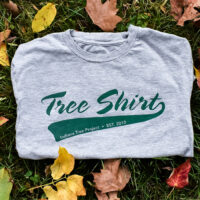
Along with each shirt, you’ll receive an official tree certificate with a unique tree ID and the coordinates for the acre where the tree will be planted. If you are interested in participating in the next public tree planting, please e-mail Cheryl Hampton at champton@dnr.in.gov to receive updates.
The types of trees planted are native Indiana hardwoods and typically upland and bottomland oaks, walnut, black cherry and other species that are in need of restoration.
To buy a shirt and learn more please visit the store page.
For more information on the Indiana Tree Project please visit the Indiana Natural Resources Foundation.
Sign up to receive the MyDNR Newsletter by email: MyDNR Email Newsletter
Resources:
Investing in Indiana Woodlands, The Education Store
Forest Improvement Handbook, The Education Store
ID That Tree, Purdue Extension-Forestry & Natural Resources (FNR) YouTube playlist
Woodland Management Moment , Purdue Extension-FNR YouTube playlist
Find an Arborist, International Society of Arboriculture
Planting Your Tree Part 1: Choosing Your Tree, Purdue Extension YouTube Channel
Native Trees of the Midwest, The Education Store
Shrubs and Woody Vines of Indiana and the Midwest, The Education Store
Finding help from a professional forester, Indiana Forestry & Woodland Owners Association
District Foresters for 10 plus acres, Indiana Department of Natural Resources
Indiana Department of Natural Resources
Purdue Landscape Report: Temperatures are finally dropping and leaves are changing color. Autumn is progressing well in my opinion. Before you know it winter will be here, and some people will be wondering is there anything to be done to better protect the trees around you? The answer is yes, and I applaud you for your initiative to continue caring for your trees. To give your trees the best chance to survive the winter and better thrive next year there is an assortment of activities available ranging from diy projects up to calling in an ISA certified arborist to help you out.
Mulching:
One simple task to better prepare your trees for winter is to add a new layer of mulch, which benefits your trees in multiple ways. Adding a 2-3 inch thick layer of mulch will better maintain moisture levels and buffer extreme temperature changes in the soil and will add some organic matter too. Mulching to the drip line will benefit the tree the most, but in the case of larger trees it’s not always feasible. Try for at least a 3-foot radius from the trunk and make sure to leave a 2 inch or so gap between the trunk and the mulch. Remember, no volcano mulching.
Fertilizing:
That mulch you just added will add some organic material to your soil as it slowly breaks down, but an autumn fertilization can benefit your trees too. Unlike trees in the forest that have a natural supply of nutrients from fallen leaves and twigs, trees around our homes are usually deprived as we rake and clean up our yards. Adding a slow-release fertilizer in the fall helps provide a nutrient boost over the winter, can promote root growth, and better prepare your tree for Spring.
Watering:
Water is still an essential part of your tree care plan, but as temperatures drop and trees begin to head into dormancy they don’t need as much water as is required in the hit summer months. If you have irrigation systems in your yard start to drop the frequency of watering. You can water up until the first freeze, but make sure soils are just a little damp and not soaked. Evergreens in particular will benefit from slow deep watering 1-2 times a week until the soil freezes. Winter winds and temperatures can desiccate the needles without an adequate supply of water.
Pruning:
Now is a good time to prune out any dead, damaged, or diseased limbs in your trees. If you have access to hand saws and pole saws or pruners, you can remove smaller branches or those closer to the ground. Make sure you are making proper pruning cuts though, and if there are large limbs, those at heights, or you are just unsure of how to make a good cut enlist the help of a professional arborist.
Trunk damage:
Sunscald or southwest damage occurs on young and/or thin barked trees in the winter. Wounds can occur between the south to southwest facing part of the trunk on sunny days in the winter as temperatures rise and suddenly drop. Over time these wounds can become quite large. Trees can also incur damage from deer during the rut. Bucks will scrape trees with their antlers, scraping off the bark and damaging the cambium. Both of these injuries can be reduced one younger trees by installing tree guards in the fall. Tree guards are plastic barriers you place around the main stem of the tree. I recommend using white corrugated drainage pipe that can be found at most home centers. You can make a cut lengthwise along the pipe for easy installation and make sure it has a large enough diameter to leave a space between it and the tree. Just remember to remove it come Spring.
Inspections:
Visual inspections can be done year-round, but this time of the year it might be easier to see changes in your tree as leaves are falling and the canopy becomes more visible. From the ground up to the canopy, some of the things you’re looking for include fungal growth around the base of the tree, any sort of damage on the main stem or branches, premature leaf drop or color change, and branches that are dead, cracked, diseased, or seem weak. Any concerns you find are also great information to share with an ISA Certified arborist which can be found using the Trees Are Good website.
To view this full article and other Purdue Landscape Report articles, please visit Purdue Landscape Report.
Subscribe and receive the newsletter: Purdue Landscape Report Newsletter.
Resources:
Re-mulch Your Trees, Purdue Landscape Report
Pruning, Purdue Landscape Report
Southwest Damage/Sunscald, Purdue Landscape Report
Planning the Tree Planting Operation, The Education Store, Purdue Extension’s resource center
Tree Risk Management, The Education Store
Tree Planting Part 2: Planting Your Tree, The Education Store
Planting Your Tree Part 1: Choosing Your Tree, Purdue Extension – Forestry and Natural Resources (FNR) YouTube Channel
Summer Tree Care, Purdue Landscape Report
Tree Defect Identification, The Education Store
Tree Wound and Healing, Got Nature? Blog, Purdue Extension – FNR
Surface Root Syndrome, The Education Store
Shrubs and Woody Vines of Indiana and the Midwest, The Education Store
Ask an Expert: Tree Selection and Planting, Purdue Extension-FNR YouTube playlist
ID That Tree, Purdue Extension-FNR YouTube playlist
Subscribe – Purdue Extension-FNR YouTube Channel
Ben McCallister, Urban Forestry Specialist
Purdue Forestry & Natural Resources
Purdue Landscape Report: Dead man’s fingers is an apt moniker for a gruesome-looking fungus (Xylaria polymorpha and related species) that produces club-shaped fungal fruiting bodies that appear as fingers growing around the base of dying or dead woody plants and even wooden objects in soil (Fig. 1). With more than 25 species of Xylaria, generalizations are difficult to make (Fig. 2), but we will persevere anyways, recognizing that some Xylaria species are limited to a saprophytic existence decomposing wood (like X. polymorpha) while others, like X. mali, cause an opportunistic black root rot on apple and crabapple (Rogers, 1984; Rogers and Callen, 1986) or nothing at all (Fig. 2). Other Xylaria species infect Norway maple, honey-locust, elm and pears (flowering and edible). Perhaps the scariest thing about dead man’s fingers is its taxonomy: X. polymorpha is an extremely variable and complicated species showing “multiple interfaces and intergradations with numerous other taxa” making speciation a challenge (Lee et al, 2000), which may explain why a crabapple with a bad graft union covered in dead man’s fingers looks otherwise healthy!
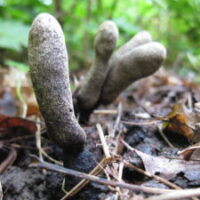
Figure 1. Dead man’s fingers is an apt moniker to describe the fruiting body of Xylaria species. Photo by Janna Beckerman.
Symptoms and Signs
Symptoms of infection by Xylaria may appear as stress and decline, including slowed growth, dieback, premature autumn coloration and leaf drop, and even crown or structural root cankers. Apple, crabapple or pear trees infected may produce an unusually large crop of undersized fruit.
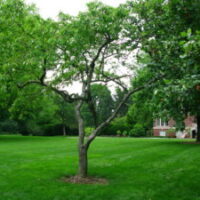
Figure 3a. Dead man’s fingers can be found associated with otherwise healthy, asymptomatic trees, or simply growing on dead wood—not necessarily causing disease.
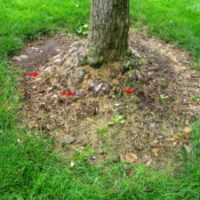
3b. Close-up of the rootstock with multiple croppings of Xylaria on the crown. Photo by Janna Beckerman.
Signs of Xylaria are more readily identified—namely, the dead man’s fingers (Fig. 4)! The club shaped, fingerlike fruiting bodies appear singularly or as clustered “fingers” about 1- 4 inches high, often at the base of infected or dying trees, or nearby large structural roots (Fig 4). In the spring, ascospores are produced by the “fingers”, creating a bluish bloom on the tips of the fingers. Cutting into a finger reveals a white interior with black bubbles that produce the sexual spores (ascospores). The “fingers” can release these spores for several months or years. In the spring, Xylaria can produce asexual spores (called conidia) anywhere on its surface, while also producing threadlike structures (called hyphae) that grow through dead or dying wood. Xylaria can survive as hyphae in roots for up to 10 years and can spread from plant to plant via hyphae when plant roots contact each other.
To view this full article and other Purdue Landscape Report articles, please visit Purdue Landscape Report
Subscribe and receive the newsletter: Purdue Landscape Report Newsletter.
Resources:
Tree Defect Identification, The Education Store
Tree wounds and healing, Got Nature? Blog
Tree Risk Management, The Education Store
Why Is My Tree Dying?, The Education Store
The Woody Plant Seed Manual, U.S. Forest Service
Native Trees of the Midwest, The Education Store
Invasive Species, Playlist, Purdue Extension – FNR YouTube Channel
Report Invasive Species, Purdue Invasive Species
Find an Arborist, International Society of Arboriculture
Subscribe Purdue Extension-Forestry and Natural Resources YouTube Channel
Janna Beckerman, Professor of Plant Pathology
Purdue Department of Botany
MyDNR, Indiana’s Outdoor Newsletter: We need the public’s help to update The Big Tree Registry, a list of the largest known specimen of each native tree species in Indiana.
“Indiana’s currently tallest recorded tree is a 152-foot-tall bitternut hickory, and our widest tree circumference is a silver maple at more than 361 inches,” said Jacob Roos, DNR urban forestry director. “We need help getting out across the state to find our new record-setting trees.”
That means it’s time to review the recently updated champions list and start looking for new candidates to nominate for the list, which is maintained by DNR’s Division of Forestry.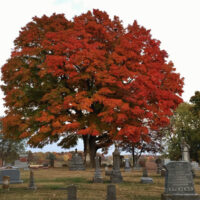 Three measurements are required:• trunk circumference, in inches, at 4 1/2 feet above the ground;• total height, in feet;• and average crown spread, in feet.The total size of each tree nominated is calculated by adding the circumference and height to a quarter of the average crown spread.The individual tree of each Indiana native tree species with the highest total points will be that species’ Big Tree champion. All nominations are reviewed, but only those with the highest scores will be verified.
Three measurements are required:• trunk circumference, in inches, at 4 1/2 feet above the ground;• total height, in feet;• and average crown spread, in feet.The total size of each tree nominated is calculated by adding the circumference and height to a quarter of the average crown spread.The individual tree of each Indiana native tree species with the highest total points will be that species’ Big Tree champion. All nominations are reviewed, but only those with the highest scores will be verified.
To see full post please visit IN DNR, It’s Time to Start Looking for Big Trees.
To learn more please visit The Big Tree Registry, IN DNR-Division of Forestry.
Sign up to receive the MyDNR Newsletter by email: MyDNR Email Newsletter
Resources:
Investing in Indiana Woodlands, The Education Store
Forest Improvement Handbook, The Education Store
ID That Tree, Purdue Extension-Forestry & Natural Resources (FNR) YouTube playlist
Woodland Management Moment , Purdue Extension-FNR YouTube playlist
Find an Arborist, International Society of Arboriculture
Planting Your Tree Part 1: Choosing Your Tree, Purdue Extension YouTube Channel
Native Trees of the Midwest, The Education Store
Shrubs and Woody Vines of Indiana and the Midwest, The Education Store
Finding help from a professional forester, Indiana Forestry & Woodland Owners Association
District Foresters for 10 plus acres, Indiana Department of Natural Resources
Indiana Department of Natural Resources
Purdue Landscape Report: Many trees are planted for their beautiful fall color, especially in locations where the climate provides reliable autumn weather. I have said this multiple times during extension talks and conversations with submitters to the Purdue Pest & Plant Diagnostic Lab (PPDL), but I seem to have not experienced a ‘normal’ fall since moving to Indiana with how erratic the weather has been from year to year. Depending on weather conditions, such as high heat and drought, colors may develop early or may be duller for specific varieties than expected.
However, individual trees that begin to show fall colors earlier than expected (August, September, even early October) may be shouting out a proverbial cry for help. Plants will often show yellow or red foliage coloration during periods of stress, so this may occur at any point during spring, summer, or fall. Individual trees may also show fall coloration earlier than others of their species in the same area. Now is the time to keep an eye out for this kind of early fall color as it can give you a heads-up on issues you can expect next year.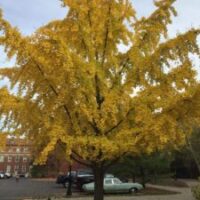
When examining a tree with early fall color, I would recommend checking the following:
- Is there a root flare?
Purdue Landscape Report: Deep Planting article- If not – tree could be planted too deep or the soil grade may have been changed
- Is there any obvious damage to the trunk, root flare, or surface roots?
- If so, there could internal decay that is not obvious and could be contributing to stress
- Are there any girdling roots?
Purdue Landscape Report: Stem Girdling Roots article- If present, they could be affecting the vascular system and strangling the tree
- Is the rootzone mulched?
- If not, the tree could be under stress from earlier drought, or weed and grass competition.
- If so, make sure it is not mounded against the trunk of the tree
- Does the soil appear compacted? Was there construction near the tree within the last 5 years?
- Compaction leads to issues with water, nutrient, and even oxygen availability to the roots and could lead to general decline
It is important to know the host species, but with the sheer volume of plant material available for sale in the nursery trade, it is even more important to know the cultivar that you are planting so you know what you might expect coming into the fall.
To view this full article and other Purdue Landscape Report articles, please visit Purdue Landscape Report.
Subscribe and receive the newsletter: Purdue Landscape Report Newsletter.
Resources:
Why Fall Color is Sometimes a Dud, Purdue Landscape Report
Forest Migration Plays a Role in Fall Foliage Colors, Purdue College of Agriculture News
U.S. Forest Service Fall Colors, Forest Service, U.S. Department of Agriculture
ID That Tree Fall Color: Sugar Maple, Purdue Extension – Forestry and Natural Resources YouTube Channel, ID That Tree Playlist
ID That Tree Fall Color Edition: Black Gum, Purdue Extension – FNR YouTube Channel, ID That Tree Playlist
Autumn Highlights Tour – South Campus, Purdue Arboretum Explorer
Why Leaves Change Color – the Physiological Basis, The Education Store, Purdue Extension resource center
Subscribe, Purdue Extension-Forestry and Natural Resources YouTube Channel
Planting Your Tree Part 1: Choosing Your Tree, Purdue Extension YouTube Channel
Summer Tree Care, Purdue Landscape Report
Tree Defect Identification, The Education Store
Tree Wound and Healing, Got Nature? Blog, Purdue Extension – Forestry and Natural Resources
Surface Root Syndrome, The Education Store
Shrubs and Woody Vines of Indiana and the Midwest, The Education Store
Ask an Expert: Tree Selection and Planting, Purdue Extension-Forestry & Natural Resources (FNR) YouTube playlist
ID That Tree, Purdue Extension-FNR YouTube playlist
John Bonkowski, Plant Disease Diagnostician
Departments of Botany & Plant Pathology
Recent Posts
- Smooth Patch of Oak – Purdue Landscape Report
Posted: March 27, 2025 in Forests and Street Trees, Urban Forestry, Wildlife, Woodlands - ID That Tree: Invasive Amur Honeysuckle
Posted: February 21, 2025 in Forests and Street Trees, Wildlife, Woodlands - A Woodland Management Moment: Seeding Into Slash Piles
Posted: February 15, 2025 in Forests and Street Trees, Urban Forestry, Woodland Management Moment, Woodlands - ID That Tree: Shrubs Edition – Leatherwood
Posted: February 7, 2025 in Forests and Street Trees, How To, Urban Forestry, Woodlands - Woodland Management Moment: Small Forest Openings
Posted: January 23, 2025 in Forestry, Forests and Street Trees, Urban Forestry, Wildlife, Woodland Management Moment, Woodlands - ID That Tree: Prickly Ash
Posted: December 16, 2024 in Forestry, Forests and Street Trees, Urban Forestry, Wildlife - Tips on How You Can Recycle Your Christmas Tree
Posted: in Ask the Expert, Christmas Trees, Forestry, Forests and Street Trees, How To, Wildlife - Ask An Expert: Holidays in the Wild
Posted: December 9, 2024 in Christmas Trees, Forestry, Forests and Street Trees, How To, Plants, Wildlife, Woodlands - Botryosphaeria Dieback and Canker, Purdue Landscape Report
Posted: November 13, 2024 in Forests and Street Trees, How To, Invasive Plant Species, Urban Forestry - Leaving Leaves Benefits Wildlife – Wild Bulletin
Posted: November 11, 2024 in Forestry, Forests and Street Trees, Gardening, Urban Forestry, Wildlife
Archives
Categories
- Alert
- Aquaculture/Fish
- Aquatic/Aquaculture Resources
- Ask the Expert
- Christmas Trees
- Community Development
- Disease
- Drought
- Forestry
- Forests and Street Trees
- Gardening
- Got Nature for Kids
- Great Lakes
- How To
- Invasive Animal Species
- Invasive Insects
- Invasive Plant Species
- Land Use
- Natural Resource Planning
- Nature of Teaching
- Plants
- Podcasts
- Ponds
- Publication
- Safety
- Spiders
- Timber Marketing
- Uncategorized
- Urban Forestry
- Webinar
- Wildlife
- Wood Products/Manufacturing
- Woodland Management Moment
- Woodlands
